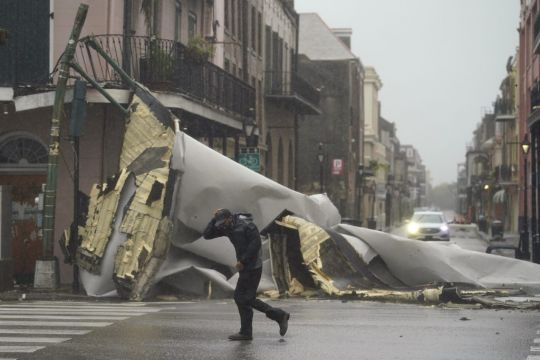Hurricane Ida blasted ashore the Louisiana coast on Sunday as one of the most powerful storms ever to hit the US.
The storm knocked out power to all of New Orleans, blowing roofs off buildings and reversing the flow of the Mississippi River as it rushed from the Louisiana coast into one of the nation’s most important industrial corridors.
Ida was blamed for at least one death: a person found dead following a report of a fallen tree on a home in Prairieville, the Ascension Parish Sheriff’s Office said on Facebook. Prairieville is a suburb of Baton Rouge, Louisiana’s capital city.
The power outage in New Orleans heightened the city’s vulnerability to flooding and left hundreds of thousands of people without air conditioning and refrigeration in sweltering summer heat.
Ida — a Category 4 storm — hit on the same date Hurricane Katrina ravaged Louisiana and Mississippi 16 years earlier, coming ashore about 45 miles (72 kilometres) west of where Category 3 Katrina first struck land.
Ida’s 150 mph (230 kph) winds tied it for the fifth-strongest hurricane to ever hit the mainland US.
It dropped hours later to a Category 1 storm with maximum winds of 95 mph (155 kph) as it crawled inland, its eye about 45 miles (70 kilometres) northwest of New Orleans.
Significant flooding was reported late on Sunday night in LaPlace, a community adjacent to Lake Pontchartrain, meteorologists in New Orleans said. Many people took to social media, pleading for boat rescues as the water rose.
The rising ocean swamped the barrier island of Grand Isle as landfall came just to the west at Port Fourchon. Ida made a second landfall about two hours later near Galliano.
The hurricane was churning through the far southern Louisiana wetlands, with the more than 2 million people living in and around New Orleans and Baton Rouge under threat.
Governor John Bel Edwards told The Associated Press: “This is going to be much stronger than we usually see and, quite frankly, if you had to draw up the worst possible path for a hurricane in Louisiana, it would be something very, very close to what we’re seeing.”
People in Louisiana woke up to a monster storm after Ida’s top winds grew by 45 mph (72 kph) in five hours as the hurricane moved through some of the warmest ocean water in the world in the northern Gulf of Mexico.
The entire city of New Orleans was without power late on Sunday, according to city officials.
The city’s power supplier — Entergy — confirmed that the only power in the city was coming from generators, the city’s Office of Homeland Security & Emergency Preparedness said on Twitter.
The message included a screen shot that cited “catastrophic transmission damage” for the power failure.
The city relies on Entergy for backup power for the pumps that remove storm water from city streets. Rain from Ida is expected to test that pump system.
More than 1 million customers were without power in Louisiana, and over 40,000 were in the dark in Mississippi, according to PowerOutage.US, which tracks outages nationwide.
In New Orleans, wind tore at awnings and caused buildings to sway and water to spill out of Lake Ponchartrain.
The Coast Guard office in New Orleans received more than a dozen reports of breakaway barges, said Petty Officer Gabriel Wisdom.

US Army Corps of Engineers spokesman Ricky Boyette said engineers detected a “negative flow” on the Mississippi River as a result of the storm surge.
Officials said Ida’s swift intensification from a few thunderstorms to a massive hurricane in just three days left no time to organise a mandatory evacuation of New Orleans’ 390,000 residents.
The region getting Ida’s worst includes petrochemical sites and major ports, which could sustain significant damage.
It is also an area that is already reeling from a resurgence of Covid-19 infections due to low vaccination rates and the highly contagious delta variant.
New Orleans hospitals planned to ride out the storm with their beds nearly full, as similarly stressed hospitals elsewhere had little room for evacuated patients. And shelters for those fleeing their homes carried an added risk of becoming flashpoints for new infections.
Forecasters warned winds stronger than 115 mph (185 kph) threatened Houma, a city of 33,000 that supports oil platforms in the Gulf.
The hurricane was also threatening neighbouring Mississippi, where Katrina demolished oceanfront homes.
Comparisons to the August 29, 2005 landfall of Katrina weighed heavily on residents bracing for Ida.
Katrina was blamed for 1,800 deaths as it caused levee breaches and catastrophic flooding in New Orleans.
President Joe Biden approved emergency declarations for Louisiana and Mississippi ahead of Ida’s arrival. He said on Sunday the country was praying for the best for Louisiana and would put its “full might behind the rescue and recovery” effort once the storm passes.







